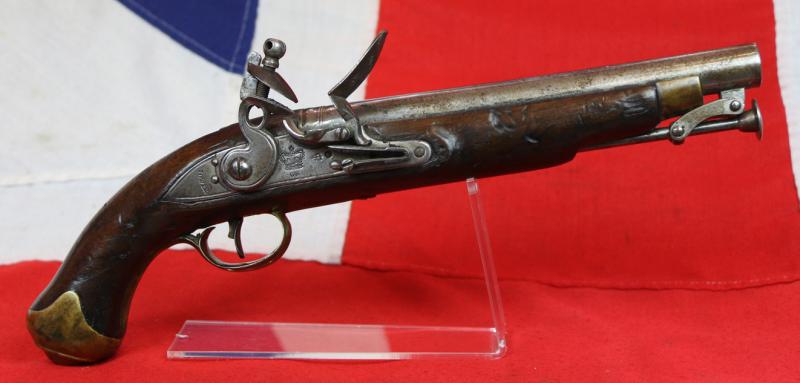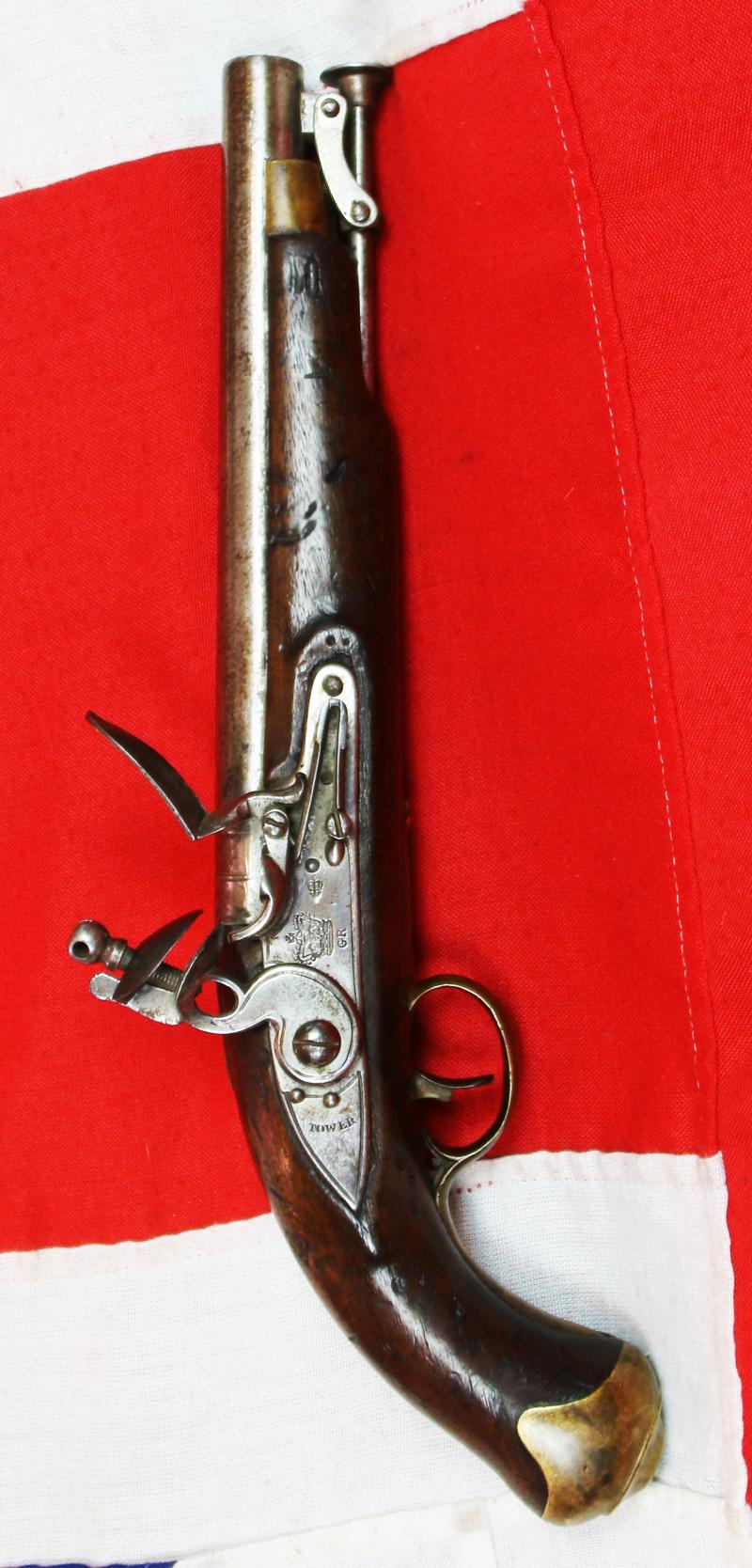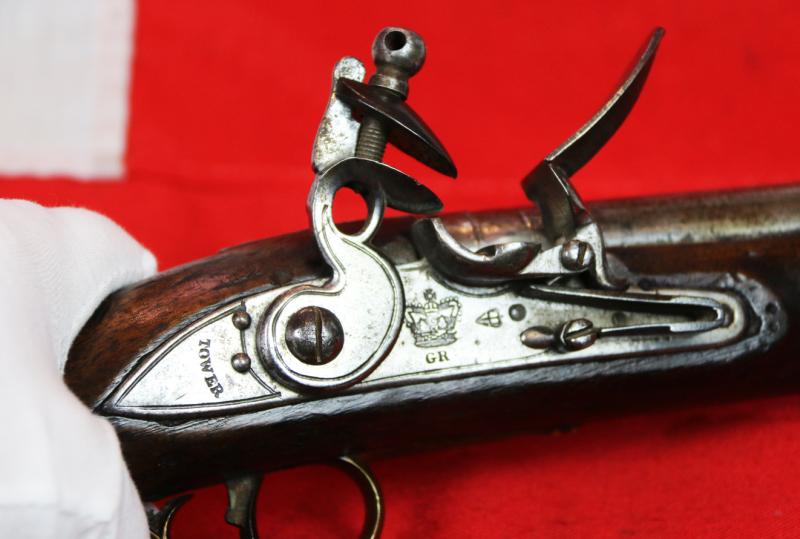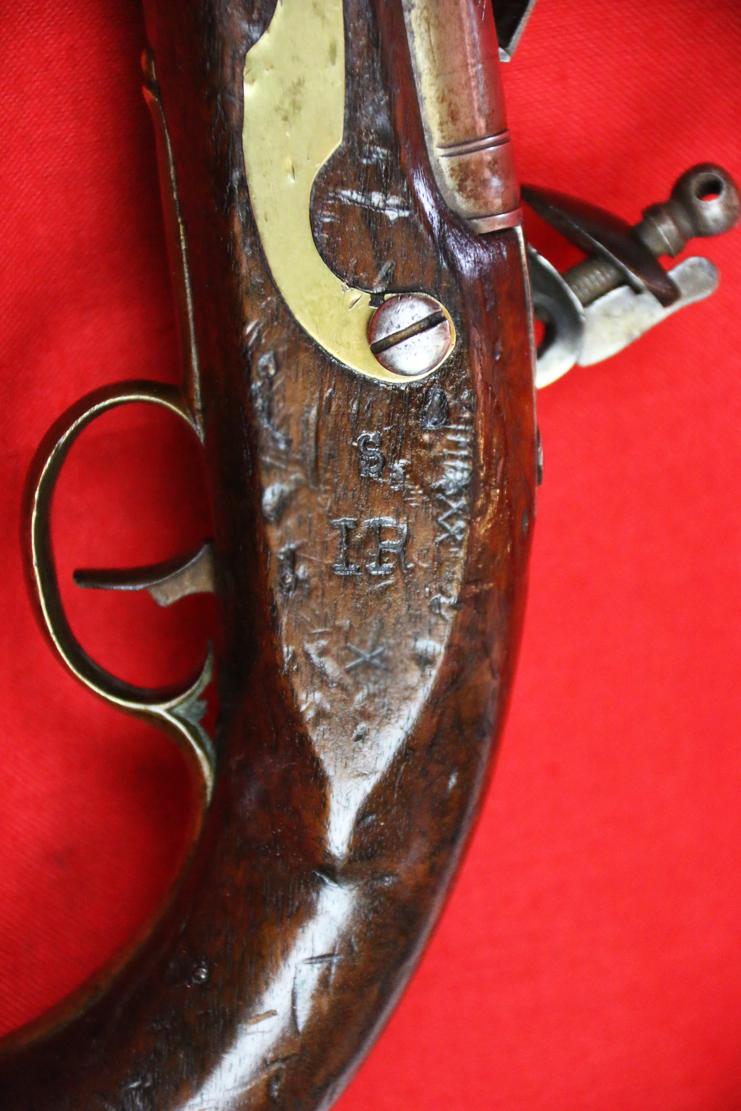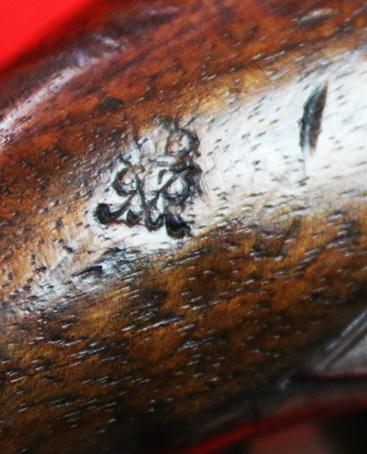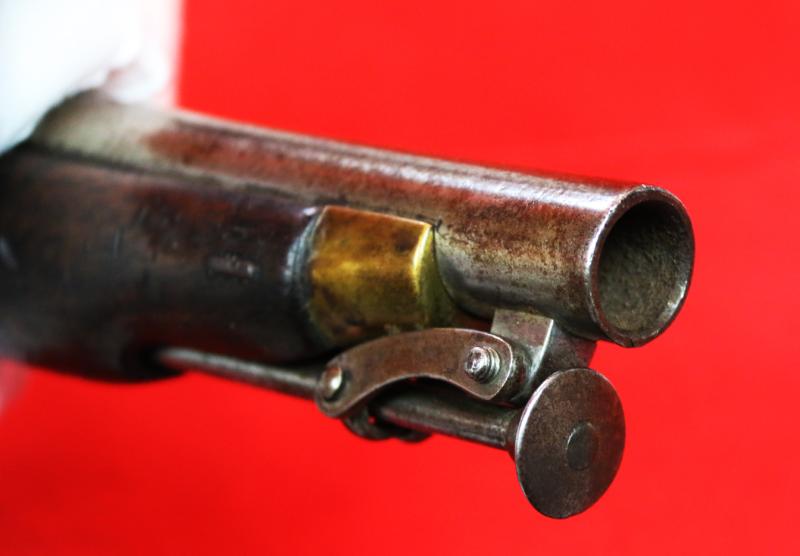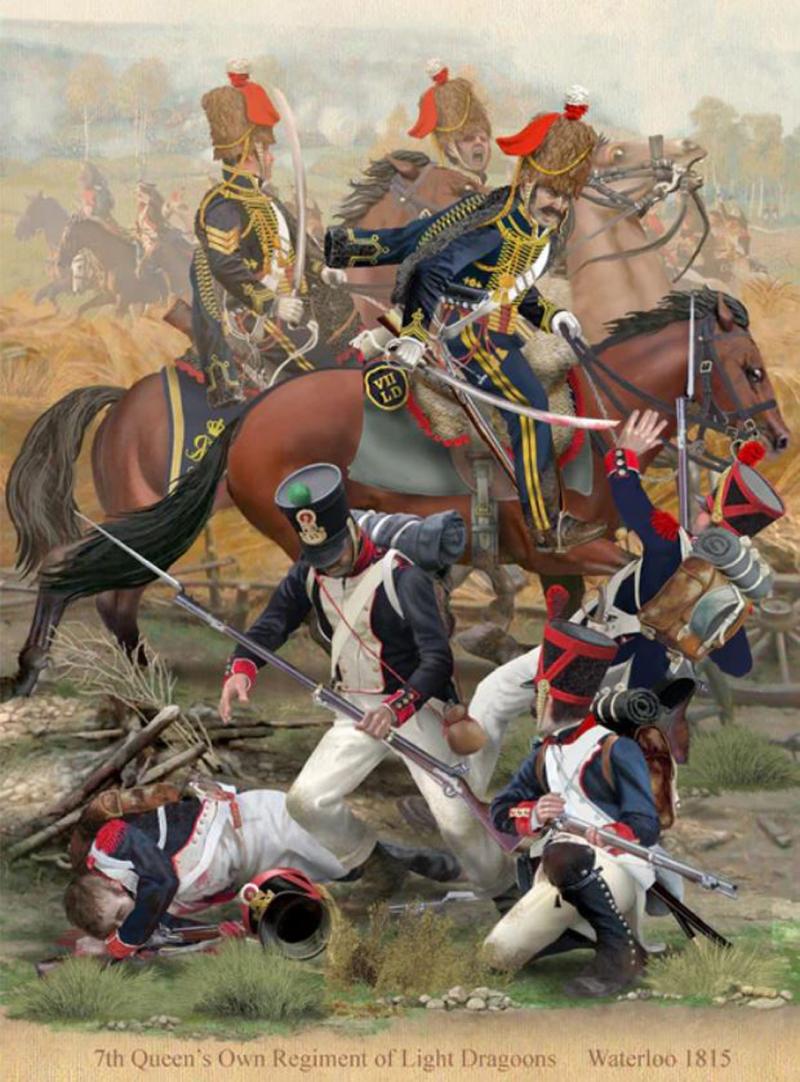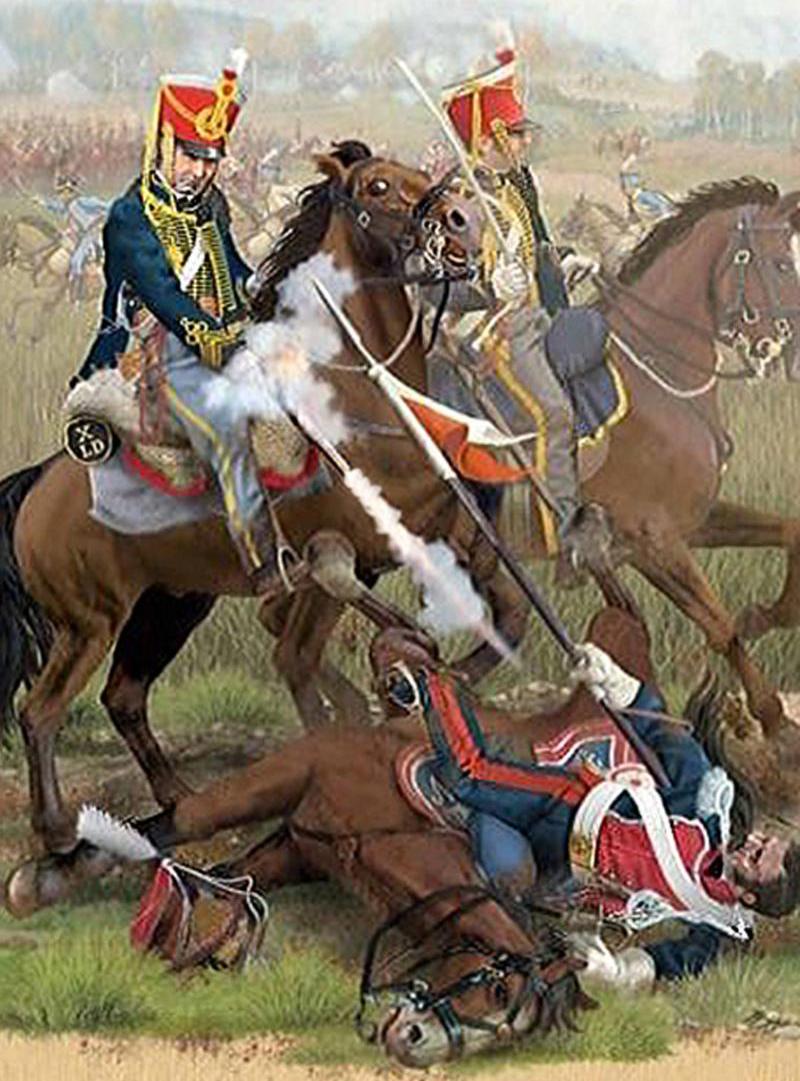A Stunning, Original, 7th Light Dragoon-Hussars GR Tower Light Dragoon Pistol. Regimentally Marked For the '7th' Regiment of Light Dragoons, '2nd' Squadron. Used By The Regiment At Corruna, Sagahun, Benavente, Orthes, Granape and Waterloo
Excellent walnut stock with original patina, numerous Board of Ordnance inspection stamps and crown stamps, GR inspection stamps to stock. Large GR Crown and Tower stamps to lock face plus inspection stamp. Stock stamp as well, the GR double inverted stamp of the Tower of London's storekeeper. The left side stock flat has the typical stamp 'IR' which is likely the ordnance stock supplier, Mr Reynold. All fine brass fittings and captive ramrod in the 'New Land' pattern form of the early 1800's {circa 1802}. In original flintlock and made at the Tower of London and used by the frontline British Cavalry 7th Light Dragoon/Hussar regiment, initially composed of 8 {troops} squadrons, of 100 troopers each, during the Peninsular War, but by the Hundred Days War, culminating at Waterloo, it was down to 380 men. At the close of the Battle of Waterloo the regiment had sustained 201 casualties: 63 killed, 121 wounded and 17 missing.
One would have to go a long way and for a considerable time to find another example in as good condition and as good quality as this one, literally untouched since its retirement form service, sometime after the Napoleonic wars. The last regimentally so marked example of the 7th, we can recall, as good as this, we were shown during one of our personal invitation visits, with our mutual dear friend {and our gunsmith of 50 years standing} Dennis Ottrey, to view the reserve Tower Collection, by the famous arms author Howard Blackmore, who was also renowned assistant keeper of the Tower.
In 1807, the regiment was designated as Hussars and retitled 7th (The Queen's Own) Regiment of (Light) Dragoons (Hussars). Sent to Corunna in October 1808 to support Sir John Moore's retreat, they fought at the Battle of Sahagún on 21 December 1808 and Benavente on 29th. Part of the Queen's Own was shipped home in the Dispatch, which was wrecked just south of the Lizard on 22 January 1809; 104 men were lost from the regiment, only seven in total were saved. The unit returned to the Peninsula in August 1813 and made several charges at the February 1814 Battle of Orthes, Wellington reporting that the 7th Hussars distinguished themselves on this occasion and made many prisoners. In March 1814, the unit moved to Brighton, where it was used to put down rioting caused by the imposition of the Corn Laws. When Napoleon was restored in 1815, the regiment returned to the Netherlands; during the rearguard action at Genappe on 17 June, Lord Uxbridge ordered it to attack French lancers under Colonel Jean Baptiste Joseph Sourd. The following day, at the Battle of Waterloo, the regiment was held in reserve until the evening, but then again undertook a series of charges. Standish O'Grady, then a lieutenant in the 7th Hussars, wrote to his father:
"We charged twelve or fourteen times, and once cut off a squadron of cuirassiers, every man of whom we killed on the spot except the two officers and one Marshal de Logis, whom I sent to the rear"
The regiment was positioned on the extreme right of the Allied line, near the Chateau of Hougoumont.
The 7th Light Dragoons were primarily a light cavalry unit, used for reconnaissance, flanking maneuvers, and pursuing the enemy.
They were located on the right flank of the Allied line, near the Chateau of Hougoumont, a key defensive point.
The 7th Hussars were involved in numerous charges, particularly in the later part of the battle, from around 5 pm. The regiment suffered significant casualties, including killed and wounded officers and other ranks. The 7th Hussars played a crucial role in the Allied victory at Waterloo, contributing to the defeat of Napoleon's forces.
In 1750 George II signed a warrant numbering Regiments, thus the 7th Queen's Own Regiment of Dragoons.Another titular change took place in 1783 when the 7th were converted to the (Queen's Own) Light Dragoons.
A decade later, their most celebrated patrons joined, Lord Henry Paget, Later the Marquis of Anglesey and John Gaspard Le Marchant, the founder of the Royal Military College at Sandhurst.
Back in England George, the Prince of Wales, was the arbiter of all fashion and as such he decided to bestow first on his own regiment, the 10th, the distinction of being Hussars in 1806. Lord Paget, now Colonel of the 7th Hussars was a friend of the Prince and thus the 7th were the second regiment to be granted the magnificent uniforms in the same year.
In October 1808 the 7th Hussars embarked for Corunna to reinforce Sir John Moore's Army. A year later the 7th were hurriedly mobilised on hearing the news that Napoleon had escaped by the Elba. Their Brigade Commander was the late Commanding Officer, Maj General Sir Hussey Vivian and their regimental Colonel, Henry Paget, Lord Uxbridge was commander of the whole British Cavalry.
On the eve of the Battle of Waterloo the 7th were Honoured by Uxbridge by being given the charge on the advancing enemy in Genappe, who were Polish Lancers. After a spirited and fearless succession of charges only nineteen of the 120 men of the 7th Hussars squadron were left in the saddle. For the Battle of Waterloo itself, the 7th were on the extreme right of the allied line, 300 yards north of the Chateau of Hougoumont. Until 5pm they were not used, but then they were charged more than twelve times.
Introduced in the 1796 and in production by 1802, the New land Cavalry Pistol provided one model of pistol for all of Britain's light cavalry and horse artillery. Another new element was the swivel ramrod which greatly improved the process of loading the pistol on horseback.
The service of British Cavalry regiments, particularly the Light Dragoons, proved essential in the mastery of the Indian Subcontinent. The Duke of Wellington, then Arthur Wellesley, was primarily recognized for his military genius by his battles in India. Of particular note was the Battle of Assaye in 1803 where the 6000 British faced a Mahratta Army of at least 40,000. During the engagement the 19th Light Dragoons saved the 74th Regiment by charging the enemy guns 'like a torrent that had burst its banks'. Pistols firing and sabre slashing, the 19th broke the enemy's position and the day was won. 19th Light Dragoons gained "Assaye" as a battle honour, and the nickname "Terrors of the East". The 19th Light Dragoons eventually served in North America during the War of 1812 and so did this form of pistol. Cavalry was the 'shock' arm, with pistol and sabre the principal hand weapons. The division between 'heavy' and light was very marked during Wellington's time: 'heavy' cavalry were huge men on big horses, 'light' cavalry were more agile troopers on smaller mounts who could harass as well as shock.
During the Napoleonic Wars, French cavalry was unexcelled. Later as casualties and the passage of years took their toll, Napoleon found it difficult to maintain the same high standards of cavalry performance. At the same time, the British and their allies steadily improved on their cavalry, mainly by devoting more attention to its organization and training as well as by copying many of the French tactics, organization and methods. During the Peninsular War, Wellington paid little heed to the employment of cavalry in operations, using it mainly for covering retreats and chasing routed French forces. But by the time of Waterloo it was the English cavalry that smashed the final attack of Napoleon's Old Guard.
We show superb Napoleonic Light Dragoons illustration prints in the gallery by David Higham, that were gifted to us by a grateful client.
These can be bought at the link below, and they are extremely comfortably priced.
https://www.printsforartssake.com/products/7th-queens-own-british-regiment-of-light-dragoons-waterloo-1815.
This is a complimentary recommendation, for which we make no financial gain
Every single item from The Lanes Armoury is accompanied by our unique Certificate of Authenticity. Part of our continued dedication to maintain the standards forged by us over the past 100 years of our family’s trading, as Britain’s oldest established, and favourite, armoury and gallery
As with all our antique guns no license is required as they are all unrestricted antique collectables
Code: 25746

